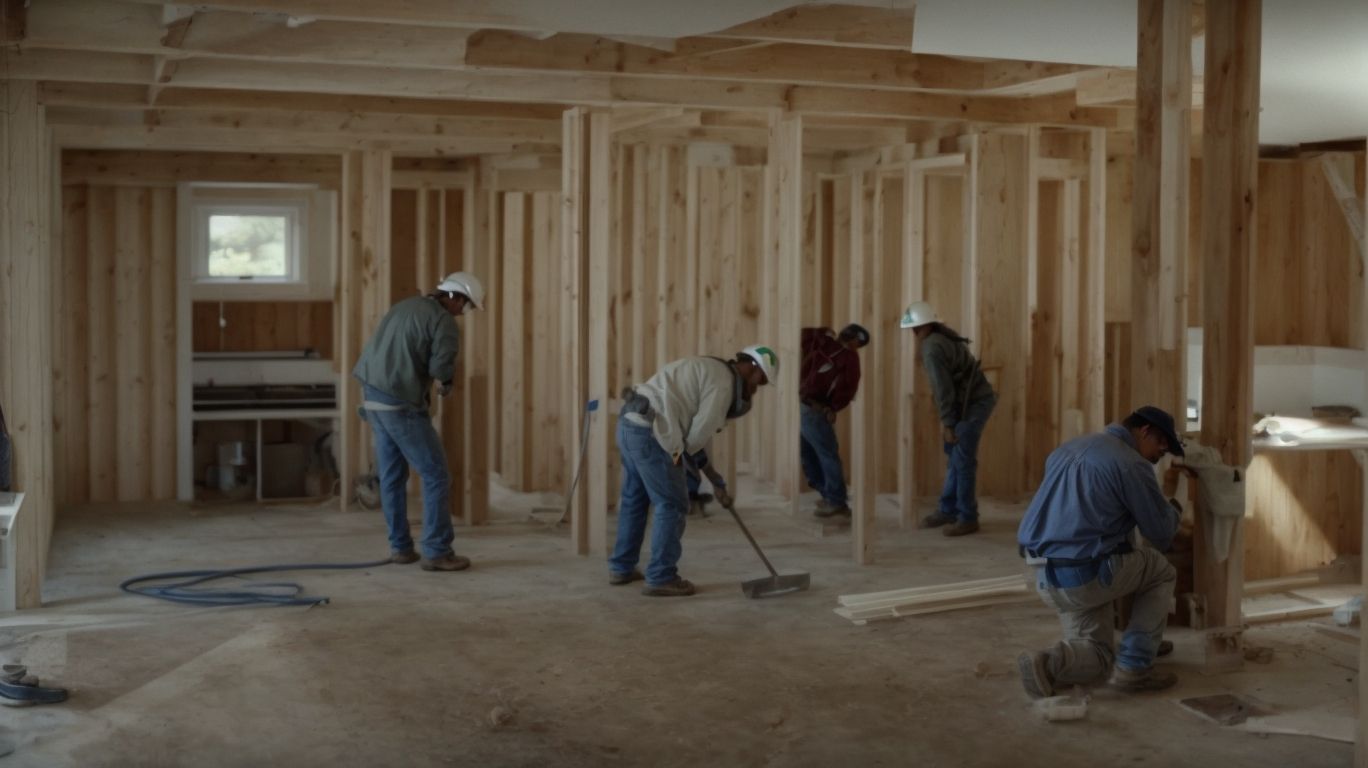
Safe Removal of Load-Bearing Walls in San Francisco Homes
Welcome to our comprehensive guide on the safe removal of load-bearing walls in San Francisco homes. In this in-depth article, we will cover everything you need to know about load-bearing walls, including how to identify them, the risks associated with their removal, and the step-by-step process for safely removing them. We will explore the tools and equipment needed for this task, as well as alternative solutions to removing load-bearing walls. We will delve into the costs involved and the potential risks of attempting a DIY removal.
Whether you’re a homeowner considering a renovation project or a curious reader wanting to learn more about structural modifications, this article will provide you with the essential knowledge and insights to make informed decisions.
What Are Load-Bearing Walls?
Load-bearing walls are essential components of a building’s structural integrity, responsible for supporting the weight of upper floors, roof systems, and other structural elements.
Ensuring the proper design and construction of load-bearing walls is crucial in maintaining the stability and safety of a residential structure. When homeowners plan renovations or modifications that involve load-bearing walls, it’s important to consider building permit requirements and consult with a structural engineer. This consultation can ensure the safe removal or alteration of load-bearing walls without compromising the building’s structural stability.
Understanding the significance of load-bearing walls can lead to informed decisions regarding the layout and design of a residential building, contributing to a safe and durable living environment.
How Do You Identify a Load-Bearing Wall?
Identifying load-bearing walls involves assessing the building’s construction plans, examining the structural blueprints, and conducting on-site evaluations to determine load-bearing elements.
This process requires a comprehensive understanding of construction regulations and building codes to ensure compliance and safety. By utilizing advanced technology such as 3D modeling and computer-aided design, engineers and architects can accurately analyze the structural integrity of load-bearing walls.
Physical inspections, including tapping walls to detect solid areas and assessing the distribution of weight, play a crucial role in identifying load-bearing walls. By combining these methods and adhering to rigorous standards, construction projects can confidently proceed with the assurance of a sound and secure structural framework.
What Are the Risks of Removing a Load-Bearing Wall?
The removal of load-bearing walls without proper consideration can pose significant risks to the structural integrity of a building, compromising construction safety and stability.
Such actions can lead to structural instability, potential collapses, and increased vulnerability to natural elements. Therefore, it is imperative to conduct a thorough engineering assessment before initiating any wall removal. Structural engineers can evaluate the building’s design, load distribution, and potential impact of wall removal, ensuring that appropriate reinforcements are implemented to maintain the structural integrity. Prioritizing construction safety and adhering to building codes is crucial, as it safeguards against hazards and ensures the longevity of the structure.
What Are the Steps for Safe Removal of Load-Bearing Walls?
The safe removal of load-bearing walls involves a meticulous process that includes consultation with a structural engineer, obtaining necessary permits, and implementing temporary support measures to ensure construction safety.
Support beams play a crucial role in redistributing the weight previously supported by the removed walls. This is achieved by installing temporary shoring to secure the structure. Wall reinforcement may be necessary to ensure the integrity of the remaining structure. It’s imperative to seek professional advice from a contractor or structural engineer to guide you through the wall removal process and ensure compliance with local building codes and regulations. They can assess the structural implications and provide insight into the appropriate support measures needed for a safe and successful wall removal.
Step 1: Consult a Structural Engineer
Initiate the process of load-bearing wall removal by consulting a qualified structural engineer who can conduct a comprehensive engineering assessment and provide insights into the necessary building permits.
This crucial step ensures the safety and stability of the structure during and after the wall removal process. The structural engineer’s expertise is essential in determining the structural integrity of the building and proposing suitable support mechanisms. They play a pivotal role in coordinating with local authorities to secure the required building permits, ensuring compliance with safety standards and regulations. Their thorough engineering assessment forms the foundation for a successful and well-executed wall removal project, safeguarding the integrity of the entire structure.
Step 2: Obtain Necessary Permits
Acquiring the essential building permits is a crucial step in the safe removal of load-bearing walls, ensuring compliance with local building regulations and mitigating construction liability.
By obtaining building permits, the homeowners and contractors demonstrate their commitment to following established guidelines and codes, which are designed to safeguard structural integrity and overall safety. Building permits also provide a formal review process to ensure that the proposed changes meet established standards.
Having the necessary permits in place mitigates the risk of legal repercussions, as it showcases a proactive approach to construction activities, reducing liability and potential risks associated with structural modifications.
Step 3: Prepare the Area
Preparing the work area for load-bearing wall removal involves:
- Ensuring construction safety
- Implementing temporary support measures
- Organizing the necessary tools and equipment for the process
Safety is a critical aspect when planning the removal of a load-bearing wall. Before embarking on the actual removal, it is essential to ensure that the area is secure and follows the required safety protocols. Temporary support beams must be carefully installed to provide stability and distribute the load appropriately. All necessary tools and equipment, such as protective gear, demolition tools, and support beams, need to be organized and readily available. Attention to these preparatory steps is crucial to the success and safety of the wall removal process.
Step 4: Provide Temporary Support
Temporary support measures, such as the installation of support beams and wall reinforcement, are crucial in maintaining construction safety and stability during the removal of load-bearing walls.
This essential temporary support ensures that the existing structure remains secure while the load-bearing walls are being taken down. Support beams play a pivotal role in redistributing the weight and maintaining the integrity of the building’s framework.
Similarly, wall reinforcement provides essential reinforcement, preventing any potential collapse or structural damage. Therefore, these measures are indispensable for ensuring the overall safety of the construction site, safeguarding both workers and the building itself.
Step 5: Remove the Wall
Carefully executing the actual wall removal process, in adherence to safety protocols, is a critical step in the overall process of load-bearing wall removal, often requiring the expertise of a qualified contractor.
This involves a systematic approach to ensure the structural integrity of the building remains intact while the wall is being removed. A skilled contractor will be able to evaluate the load-bearing capacity of adjacent structures, propose suitable support solutions, and carry out the demolition process with precision.
They must adhere to building codes and regulations to ensure the safety of the occupants and the stability of the building during and after the wall removal.
Step 6: Reinforce the Structure
Following the wall removal, reinforcing the structure with appropriate measures is essential to maintain the overall integrity and stability of the building, frequently necessitating professional advice.
This post-removal phase of wall reinforcement involves careful assessment of the load-bearing capacity and distribution within the building. Professional advice from structural engineers or architects plays a crucial role in determining the best reinforcement methods, which may include steel beams, additional support columns, or other structural enhancements.
The goal is to ensure the structural stability of the building while also optimizing the use of space and maintaining aesthetic appeal. It’s important to prioritize safety and compliance with building codes throughout the reinforcement process.
What Tools and Equipment are Needed for Safe Removal of Load-Bearing Walls?
The safe removal of load-bearing walls requires specific tools and equipment designed to facilitate the wall removal process while prioritizing construction safety and load-bearing capacity considerations.
These essential tools include:
- a sturdy sledgehammer for breaking down the wall
- a reciprocating saw for precision cutting
- a pry bar for leveraging the components apart
Support structures such as temporary walls, braces, and hydraulic jacks are imperative to maintain the load-bearing capacity during the removal process.
Personal protective equipment (PPE) is crucial, including:
- safety goggles
- gloves
- hard hats
to ensure the safety of the workers involved in the disruptive process.
What Are the Alternatives to Removing Load-Bearing Walls?
In lieu of removing load-bearing walls, alternative approaches such as installing support beams, implementing home renovation strategies, and reinforcing existing walls can be considered to achieve structural modifications.
These alternative methods provide homeowners with versatile options to redesign their living spaces without compromising the integrity of their homes. Incorporating support beams can distribute the load evenly, making it possible to open up floor plans and create more spacious environments.
Home renovation techniques, including wall reinforcement, offer a cost-effective and efficient means to enhance structural stability, ensuring that the desired modifications are achieved with minimal disruption to the existing layout.
Installing a Beam or Column
One alternative to removing load-bearing walls involves the installation of support beams or columns, compliant with building regulations and safety standards, to redistribute the structural load effectively.
This process begins with a comprehensive structural assessment by a qualified engineer to determine the appropriate placement and size of the support beams. Factors such as the building’s design, load requirements, and potential impact on the overall structure are carefully considered.
Following the assessment, the installation of support beams or columns must adhere to specific building codes and regulations to ensure the safety and stability of the construction. Professionals also take into account the long-term effects of the installation on the building’s integrity and functionality.
Adding Support from Below
Reinforcing the structure by adding support from below the load-bearing wall can be a viable alternative, often involving the installation of support beams and wall reinforcement to maintain construction safety.
Support beams, also known as structural beams, are commonly employed to distribute the weight of the structure and alleviate pressure from the load-bearing walls. By strategically positioning these support beams, the construction’s stability and load-bearing capacity can be significantly improved.
In addition, wall reinforcement techniques such as adding steel rods or increasing wall thickness can further enhance the structural integrity. Utilizing these methods not only ensures safety during construction but also provides long-term durability for the building.
Utilizing Non-Load-Bearing Walls
Utilizing non-load-bearing walls for structural enhancements or modifications through home renovation techniques and wall reinforcement can provide alternatives to the removal of load-bearing walls while ensuring structural stability.
This approach allows homeowners to transform their living spaces without compromising the integrity of the overall structure. By strategically utilizing non-load-bearing walls, interior layouts can be reconfigured to create open-concept designs, additional rooms, or improved functionality without the complexity of load-bearing wall removal. This not only offers cost-effective and time-efficient solutions but also preserves the essential support system of the building.
The integration of home renovation strategies with non-load-bearing walls showcases a versatile and sustainable approach to achieving desired structural modifications.
How Much Does It Cost to Remove a Load-Bearing Wall in San Francisco?
The cost of removing a load-bearing wall in San Francisco varies based on factors such as structural complexity, wall removal cost, and potential seismic retrofitting requirements, necessitating professional advice for accurate cost assessments.
This complexity can significantly impact the wall removal cost. For example, older buildings may require additional seismic retrofitting to ensure structural integrity, increasing the overall project expense. Professional advice is essential for accurately assessing these potential costs and determining the most cost-effective solutions for removing load-bearing walls while maintaining the building’s stability and safety.
What Are the Risks of DIY Load-Bearing Wall Removal?
Undertaking DIY load-bearing wall removal poses significant risks, including construction liability, non-compliance with building regulations, and the potential compromise of structural integrity, necessitating professional advice for safe and legal execution.
While the idea of tackling a home improvement project on one’s own can be appealing, when it comes to structural work involving load-bearing walls, the stakes are high. Inexperienced removal of load-bearing walls can lead to structural instability and compromise the safety of the entire building. From a legal standpoint, non-compliance with building regulations can result in costly fines or even the requirement to rebuild sections of the property.
It is essential to prioritize safety and legality by consulting with licensed professionals to ensure the work is carried out correctly and within the parameters of the law.




No Comments